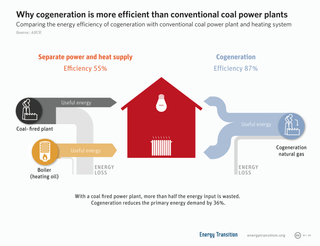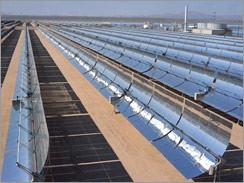
A business model describes how an organization creates, delivers, and captures value, in economic, social, cultural or other contexts. The process of business model construction and modification is also called business model innovation and forms a part of business strategy.

A public utility company is an organization that maintains the infrastructure for a public service. Public utilities are subject to forms of public control and regulation ranging from local community-based groups to statewide government monopolies.
Electricity retailing is the final sale of electricity from generation to the end-use consumer. This is the fourth major step in the electricity delivery process, which also includes generation, transmission and distribution.

Cogeneration or combined heat and power (CHP) is the use of a heat engine or power station to generate electricity and useful heat at the same time.

Municipalization is the transfer of private entities, assets, service providers, or corporations to public ownership by a municipality, including a city, county, or public utility district ownership. The transfer may be from private ownership or from other levels of government. It is the opposite of privatization and is different from nationalization. The term municipalization largely refers to the transfer of ownership of utilities from Investor Owned Utilities (IOUs) to public ownership, and operation, by local government whether that be at the city, county or state level. While this is most often applied to electricity it can also refer to solar energy, water, sewer, trash, natural gas or other services.

Fortum Oyj is a Finnish state-owned energy company located in Espoo, Finland. In addition to Finland, it is focusing on Germany and other countries in the Central Europe, Great Britain, and the Nordic. Fortum operates power plants, including co-generation plants, and generates and sells electricity and heat. The company also sells waste services such as recycling, reutilisation, final disposal solutions and soil remediation and environmental constructions services, and other energy-related services and products e.g. consultancy services for power plants and electric vehicle charging. Fortum is listed on the NASDAQ OMX Helsinki stock exchange.

The Public Utility Regulatory Policies Act is a United States Act passed as part of the National Energy Act. It was meant to promote energy conservation and promote greater use of domestic energy and renewable energy. The law was created in response to the 1973 energy crisis, and one year in advance of a second energy crisis.

District heating is a system for distributing heat generated in a centralized location through a system of insulated pipes for residential and commercial heating requirements such as space heating and water heating. The heat is often obtained from a cogeneration plant burning fossil fuels or biomass, but heat-only boiler stations, geothermal heating, heat pumps and central solar heating are also used, as well as heat waste from factories and nuclear power electricity generation. District heating plants can provide higher efficiencies and better pollution control than localized boilers. According to some research, district heating with combined heat and power (CHPDH) is the cheapest method of cutting carbon emissions, and has one of the lowest carbon footprints of all fossil generation plants.

Wärtsilä Oyj Abp, trading internationally as Wärtsilä Corporation, is a Finnish company which manufactures and services power sources and other equipment in the marine and energy markets. The core products of Wärtsilä include technologies for the energy sector, including gas, multi-fuel, liquid fuel and biofuel power plants and energy storage systems; and technologies for the marine sector, including cruise ships, ferries, fishing vessels, merchant ships, navy ships, special vessels, tugs, yachts and offshore vessels. Ship design capabilities include ferries, tugs, and vessels for the fishing, merchant, offshore and special segments. Services offerings include online services, underwater services, turbocharger services, and also services for the marine, energy, and oil and gas markets. At the end of June 2018, the company employed more than 19,000 workers.
Micro combined heat and power, micro-CHP, µCHP or mCHP is an extension of the idea of cogeneration to the single/multi family home or small office building in the range of up to 50 kW. Usual technologies for the production of heat and power in one common process are e.g. internal combustion engines, micro gas turbines, stirling engines or fuel cells.

Enmax Corporation is a vertically integrated utility that generates and distributes electricity, natural gas, renewable energy, and value-added services to customers in Alberta, Canada.
An energy service company (ESCO) is a business that provides a broad range of energy solutions including designs and implementation of energy savings projects, retrofitting, energy conservation, energy infrastructure outsourcing, power generation, energy supply, and risk management.
The Westinghouse Combustion Turbine Systems Division (CTSD), part of Westinghouse Electric Corporation's Westinghouse Power Generation group, was originally located, along with the Steam Turbine Division (STD), in a major industrial manufacturing complex, referred to as the South Philadelphia Works, in Lester, PA near to the Philadelphia International Airport.

Green Mountain Energy Company is a United States company that offers electricity products, carbon offsets, and "sustainable solutions" to residential and commercial customers.
Equipment rental, also called plant hire in some countries, is a service industry providing machinery, equipment and tools of all kinds and sizes for a limited period of time to final users, mainly to construction contractors but also to industry and individual consumers. Renting can be defined as getting equipment for a temporary purpose to help the people who are not willing to buy the equipment.
Third-party logistics in logistics and supply chain management is an organization's use of third-party businesses to outsource elements of its distribution, warehousing, and fulfillment services.
Tuas Power Ltd is one of the largest power generation companies and a key provider of energy solutions, multi-utilities and environmental services in Singapore.

HelioPower, Inc. is a US-based provider of integrated energy solutions for residential, commercial, industrial, public sector and non-profit organizations. Founded in 2001, HelioPower also develops proprietary projects with third-party offtakers and currently owns and operates more than 100 energy systems at facilities like the Tech Museum of Innovation in San Jose & Ronald McDonald House in San Diego.
Net metering in New Mexico is a set of state public policies that govern the relationship between solar customers and electric utility companies.

A consumer green energy program is a program that enables households to buy energy from renewable sources. By allowing consumers to purchase renewable energy, it simultaneously diverts the utilization of fossil fuels and promotes the use of renewable energy sources such as solar and wind.











